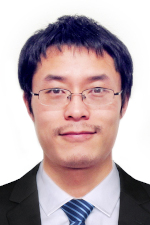个人资料
- 部门: 精密光谱科学与技术国家重点实验室
- 毕业院校: 美国科罗拉多大学
- 学位: 博士
- 学历: 博士研究生
- 邮编: 200241
- 联系电话: 021-54836112
- 传真: 无
- 电子邮箱: hcni@lps.ecnu.edu.cn
- 办公地址: 光学大楼A305
- 通讯地址: 上海市闵行区东川路500号
教育经历
| 2004.09--2008.06 | 南京大学 | 物理学学士 | | 2008.08--2014.06 | 美国科罗拉多大学 | 物理学博士 |
工作经历
| 2014.07--2018.03 | 德国马克斯普朗克复杂系统物理研究所 | 博士后(洪堡学者) | | 2018.03--2019.09 | 奥地利维也纳科技大学 | 博士后(迈特纳学者) | | 2019.09-- | 华东师范大学 | 研究员(国家海外优青) |
个人简介
主要从事超快光学、阿秒物理、强场物理、原子分子光物理理论研究。
欢迎本科生加入,欢迎报考研究生,欢迎博士后访问学者!
社会兼职
上海市青年科技人才协会会员、上海引源研究院青年理事。
中国激光杂志社青年编委会委员、Chinese Optics Letters青年编委、Ultrafast Science青年编委。
期刊审稿:Physical Review Letters; Physical Review X; Physical Review A; Physical Review B; Physical Review Research; Optics Express; Ultrafast Science; Communications Physics; Scientific Reports; New Journal of Physics; Journal of Physics A; Journal of Physics B; Journal of Physics: Photonics; Journal of Physics Communications; Journal of Optics; Frontiers in Physics; Europhysics Letters (EPL); European Physical Journal D; Science China: PMA; Chinese Physics Letters; Chinese Physics B; Atoms.
研究方向
人类对于越来越快的物理过程以及越来越短的时间尺度的追求是永无止境的。早在19世纪,人们就发明了高速摄影技术,解决了当时关于“马在奔跑过程中是否会四脚离地”的争议。1980年代,飞秒(1fs = 10-15s)激光开始发展,人们拍摄了化学反应中原子核的运动过程。目前脉冲更短的超快光源已经成熟,其脉冲长度已经缩短至阿秒(1as = 10-18s)量级,从而可以观测电子的超快运动以及化学键的形成和断裂,是当前可以分辨的最快物理过程。强场超快光物理可以在前所未有的高场强、高时间分辨率情形下开展物性研究,是目前国内外蓬勃发展的学科之一。

我们利用超强超短脉冲、运用理论分析和数值模拟、结合人工智能研究以下课题:
电离时间超快控制:观测并控制光电离、隧穿电离时刻。 光子动量传递过程:观测其光子动量如何在超快尺度上传递给电子。 化学反应相干控制:控制化学键的产生和断裂,从而控制化学反应过程及产物。 固体物理超快调控:通过跟踪固体高次谐波变化,控制固体微观过程,如拓扑态的建立等。 电子关联超快控制:调控超快过程中的电子关联作用。
你想知道如何在阿秒时间尺度观测、控制电子运动吗?加入华东师范大学精密光谱科学与技术国家重点实验室吴健教授团队倪宏程研究员课题组,我们一起追逐速度与激情!欢迎本科生加入,欢迎报考硕士、博士研究生,欢迎博士后访问学者! 本科生研究方向我们长期支持本科生从事前沿科学研究,欢迎联系。本科生(下划线)参与的论文:
Distinct role of electric field and vector potential in strong-field tunneling ionization
Yongzhe Ma#, Xiaodan Mao#, Lanhe Kong, Qingcao Liu, Hongcheng Ni*, and Jian Wu
Physical Review A 111, 033103 (2025). ▶ PDF PyStructureFactor: A Python code for the molecular structure factor in tunneling ionization rates
Shanshan Song#, Mingyu Zhu# (并列一作), Hongcheng Ni*, and Jian Wu*
Computer Physics Communications 292, 108882 (2023). ▶ PDF ▶ Code Ionization induced by the ponderomotive force in intense and high-frequency laser fields
Mingyu Zhu, Yuxiang Liu, Chunli Wei, Hongcheng Ni*, and Qi Wei*
Journal of Chemical Physics 158, 164306 (2023). ▶ PDF Influence of nonadiabatic, nondipole and quantum effects on the attoclock signal
Yongzhe Ma, Jinyu Zhou, Peifen Lu, Hongcheng Ni*, and Jian Wu*
Journal of Physics B 54, 144001 (2021). [Invited Article] ▶ PDF
课题组成员
| 
| 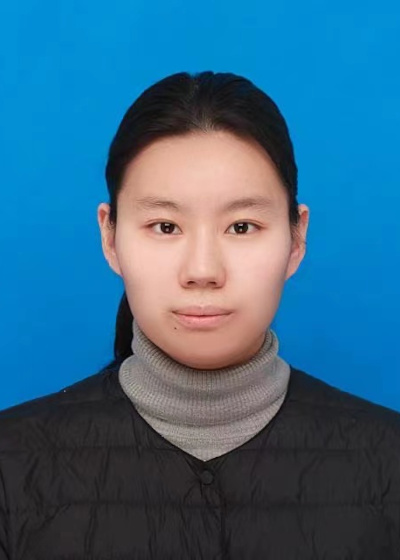
| 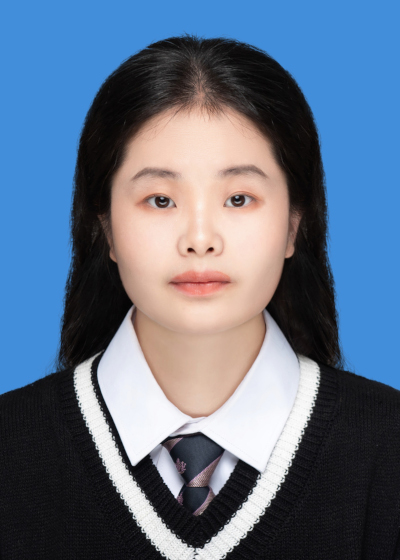
| | 高雨桐 博士生 2021入学 | 黄昊 博士生 2021入学 | 徐菁阳 博士生 2024入学 | 张茹 博士生 2024入学 |

| 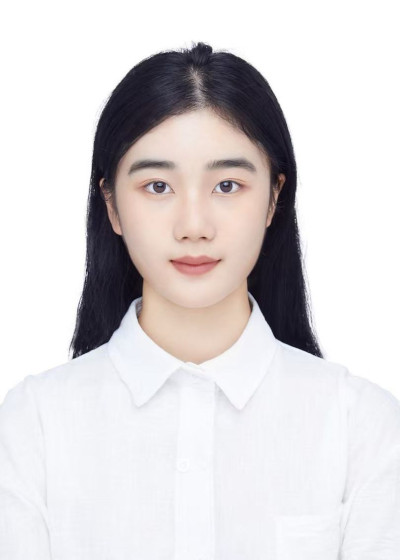
| | 朱明宇 硕士生 2025入学 | 熊苏文 硕士生 2025入学 |
往届成员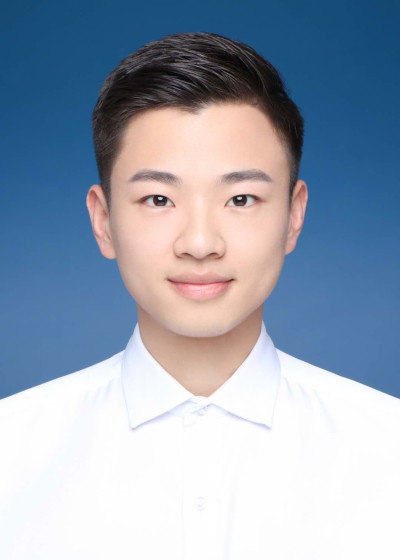
| 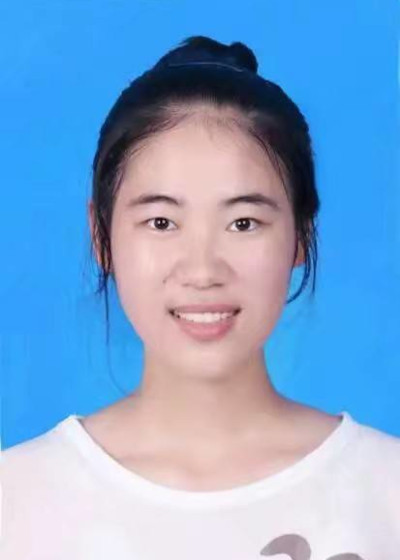
| 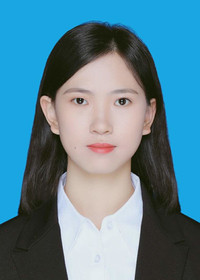
| 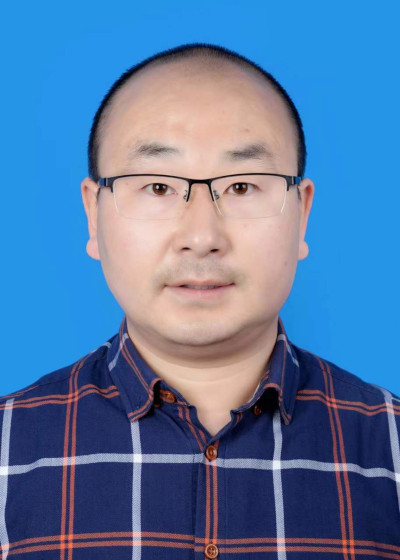
| | 马永哲 博士 2019--2024 | 毛晓丹 博士 2020--2025 | 宋姗姗 硕士 2020--2023 | 王军平 博士后 2022--2024 | | 现任 哈工大(威海) 讲师 | 现任 上海交通大学 博士后 | 现任 楷登电子 工程师 | 现任 辽宁大学 讲师 | 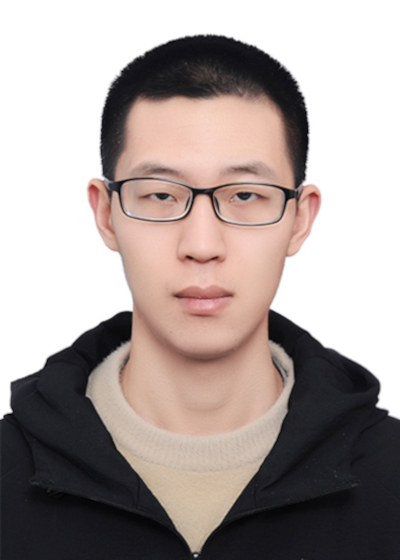
|
|
|
| | 侯豪迈 硕士 2022--2025 |
|
|
| | 现任 我武生物 AI工程师 |
|
|
|
开授课程
《超快光子学》,第五学期,专业选修,36学时2学分,倪宏程、张文斌、吴健。
科研项目
Localization and Delocalization of a Single Molecule in a Helium Nanodroplet  When embedded in superfluid helium nanodroplets, the dopant molecule exhibits either localization or delocalization behaviors that are critically determined by the spatial spread of its wavefuntion, which in turn are influenced by the confining potential of the nanodroplets. Here, we examine the spatial extent of a molecule's wavefunction with respect to the size of the nanodroplet by diagnosing the angular nodal structures in the photoelectron momentum distributions (PMDs). We find that, for the lightest H2 molecules or heavier D2 and O2 molecules, with extents of wavefunction distributions comparable to or smaller than the nanodroplet size, the emitted electrons undergo either minimal or significant scattering with the liquid helium surroundings, leading to either preserved or blurred nodal structures in the PMDs (see Figure). These observations reveal the underlying delocalization or localization of a molecule within the nanodroplet, which is governed by its wavefunctions as determined by the confining potential of the droplet. Our findings provide insight into the quantum solvation dynamics of light impurities in nanoscale and confined systems. Z. Ye, H. Hou, L. Zeng, L. Zhou, Z. Jiang, M. Shi, C. Lu, S. Pan, R. Gong, P. Lu, H. Ni, W. Zhang, F. He, and J. Wu, Phys. Rev. Lett. 135, 213202 (2025). [Editors' Suggestion] [ Featured in Physics] Photon momentum transfer and partitioning: from one to many 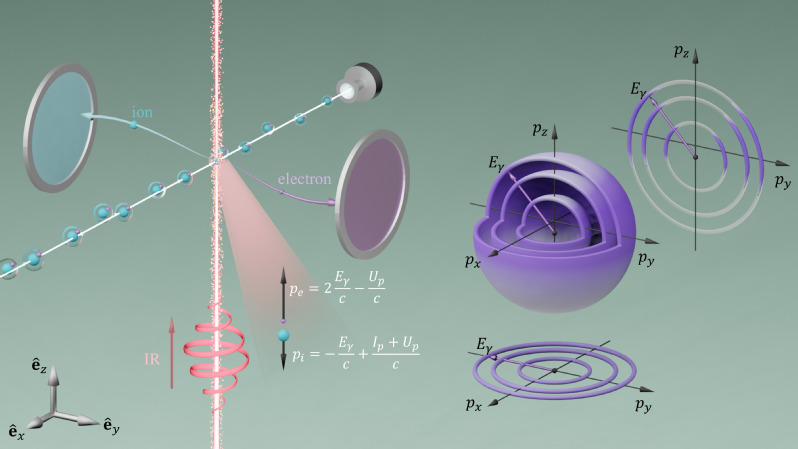 The transfer of photon momentum is indispensable in initiating and directing light-matter interactions, which underpins a plethora of fundamental physical processes from laser cooling to laser particle acceleration. The transferred photon momentum is distributed between the photoelectron and the residual ion upon ionization. Our study presents a general and consistent framework for photon momentum transfer covering an arbitrary number of absorbed photons. Our results bridge the gap between the previously considered limiting cases of single-photon and multi-photon strong-field ionization and suggest revising the current consensus for the multi-photon limit by demonstrating that with each additional photon absorbed above the ionization threshold, the photoelectron acquires on average twice the momentum of the absorbed photon (see Figure). Our work paves the pathway towards a comprehensive understanding of the fundamental processes of photon momentum transfer in light-matter interactions, with implications for both theoretical physics and practical applications that harness the transfer of photon momentum. X. Mao, H. Ni, K. Lin, P.-L. He, H. Liang, S. Eckart, F. He, K. Ueda, R. Dörner, and J. Wu, Nat. Commun. 16, 5977 (2025). eTraj.jl: Trajectory-based simulation for strong-field ionization 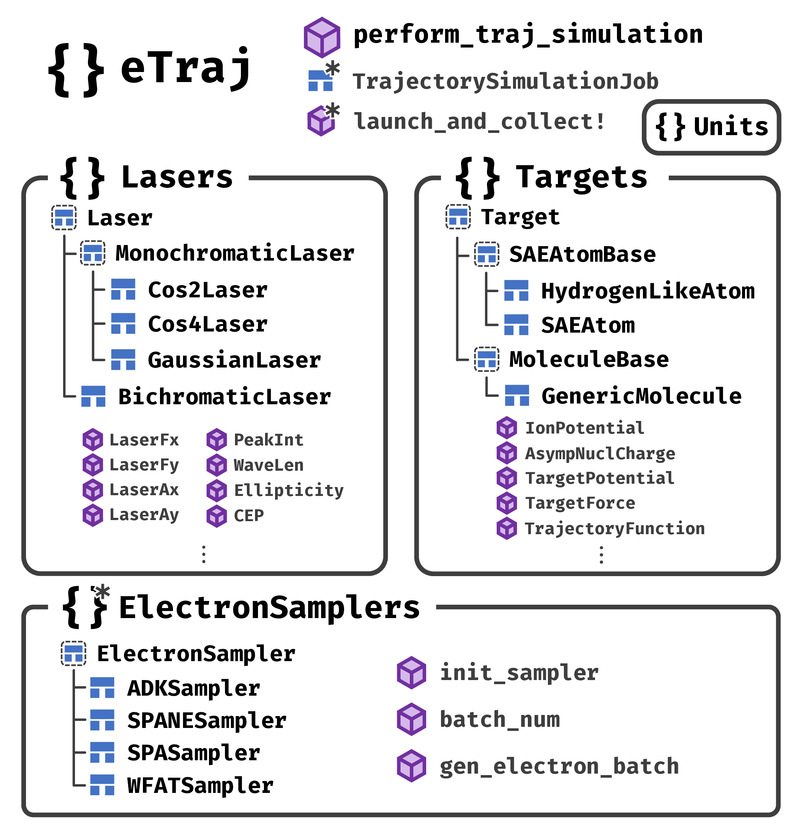 The dynamics of light-matter interactions in the realm of strong-field ionization has been a focal point and has attracted widespread interest. We present the eTraj.jl program package (see Figure), designed to implement established classical/semiclassical trajectory-based methods to determine the photoelectron momentum distribution resulting from strong-field ionization of both atoms and molecules. The program operates within a unified theoretical framework that separates the trajectory-based computation into two stages: initial-condition preparation and trajectory evolution. For initial-condition preparation, we provide several methods, including the Strong-Field Approximation with Saddle-Point Approximation (SFA-SPA), SFA-SPA with Non-adiabatic Expansion (SFA-SPANE), and the Ammosov-Delone-Krainov theory (ADK), with atomic and molecular variants, as well as the Weak-Field Asymptotic Theory (WFAT) for molecules. For trajectory evolution, available options are Classical Trajectory Monte-Carlo (CTMC), which employs purely classical electron trajectories, and the Quantum Trajectory Monte-Carlo (QTMC) and Semi-Classical Two-Step model (SCTS), which include the quantum phase during trajectory evolution. The program is a versatile, efficient, flexible, and out-of-the-box solution for trajectory-based simulations for strong-field ionization. It is designed with user-friendliness in mind and is expected to serve as a valuable and powerful tool for the community of strong-field physics. Subcycle Conservation Law in Strong-Field Ionization 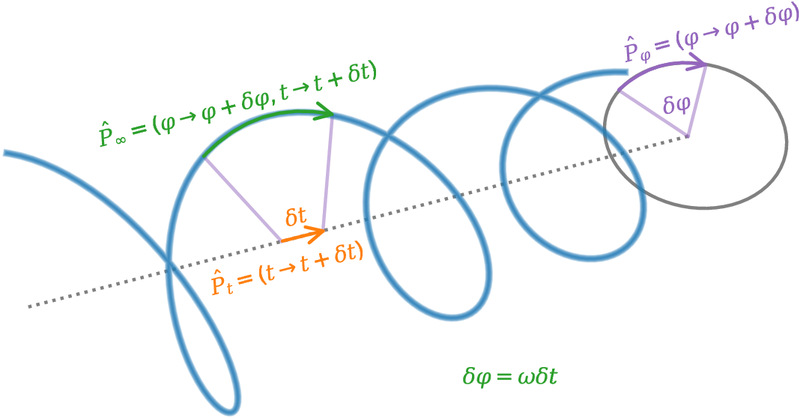 Exploiting the infinite-order continuous dynamical rotational symmetry of circularly or elliptically polarized classical light pulses (see Figure), we establish the conservation law between the angular momentum and energy in strong-field ionization that is applicable at the subcycle level. We illustrate the conservation law through the correlated spectrum of angular momentum and energy of photoelectrons, both at the tunnel exit and in the asymptotic region. Moreover, we propose a protocol based on electron vortices to directly visualize the existence of the subcycle conservation law. Our work paves the pathway toward a deeper understanding of fundamental light–matter interactions on the subcycle scale. Y. Ma, H. Ni, Y. Li, F. He, and J. Wu, Ultrafast Sci. 4, 0071 (2024). Y. Ma, X. Mao, L. Kong, Q. Liu, H. Ni, and J. Wu, Phys. Rev. A 111, 033103 (2025). X. Mao, K. Liu, H. Ni, and J. Wu, Phys. Rev. A 111, 033113 (2025). Light-driven bimolecular reaction dynamics 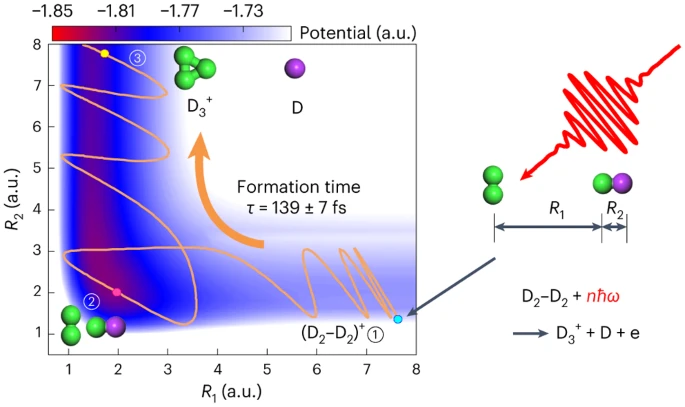 The light-driven formation of trihydrogen cation has been attracting considerable attention because of its important role as an initiator of chemical reactions in interstellar clouds. To understand the formation dynamics, most previous studies focused on creating H3+ or D3+ from unimolecular reactions of various organic molecules. Here we observe and characterize the ultrafast formation dynamics of D3+ from a bimolecular reaction (see Figure), using pump–probe experiments that employ ultrashort laser pulses to probe its formation from a D2–D2 dimer. Our molecular dynamics simulations provide an intuitive representation of the reaction dynamics, which agree well with the experimental observation. We also show that the emission direction of D3+ can be controlled using a tailored two-colour femtosecond laser field. The underlying control mechanism is in line with what is known from the light control of electron localization in the bond breaking of single molecules. L. Zhou, H. Ni, Z. Jiang, J. Qiang, W. Jiang, W. Zhang, P. Lu, J. Wen, K. Lin, M. Zhu, R. Dörner, and J. Wu, Nat. Chem. 15, 1229 (2023). Z. Jiang, H. Huang, C. Lu, L. Zhou, S. Pan, J. Qiang, M. Shi, Z. Ye, P. Lu, H. Ni, W. Zhang, and J. Wu, Nat. Commun. 15, 2854 (2024). M. Shi, H. Huang, C. Lu, S. Pan, L. Zhou, Z. Jiang, H. Ni, W. Zhang, and J. Wu, Phys. Rev. X 14, 041001 (2024). H. Huang, H. Hou, J. Wen, H. Ni, and J. Wu, Phys. Rev. A 109, 043107 (2024). Featured in News&Views. PyStructureFactor: A Python code for the molecular structure factor in tunneling ionization rates 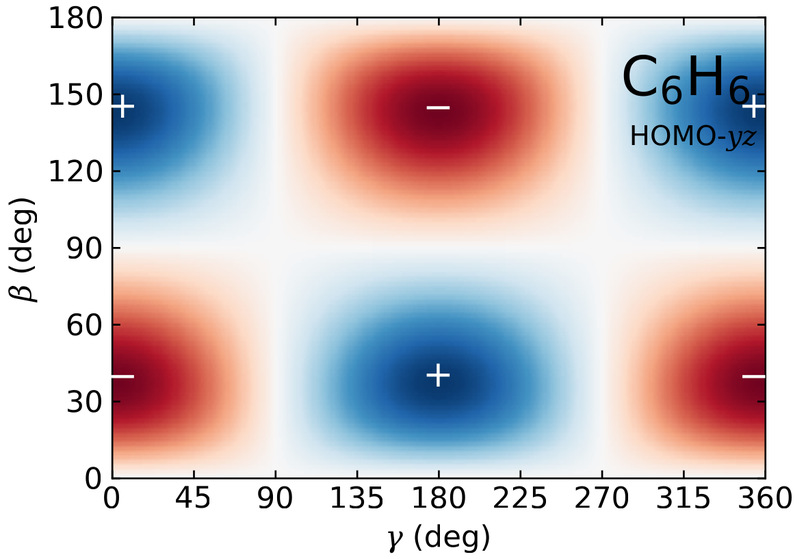 Tunneling ionization is at the core of strong-field and attosecond science. In this work, we present PyStructureFactor — a general Python code towards the calculation of the structure factor in the tunneling ionization rate of common molecules under intense laser fields. The numerical implementation is based on the well-developed weak-field asymptotic theory in the integral representation. The information of the electronic structure of the molecules is obtained via the PySCF quantum chemistry package. PyStructureFactor is a general computational framework that can be utilized to compute the molecular structure factor of various types of molecules, including polar and nonpolar diatomic molecules, degenerate molecules, and open-shell molecules. Examples (see Figure) are given that are benchmarked against known results with good agreements. The present PyStructureFactor is implemented in an efficient manner and is easily applicable towards larger molecules. Rydberg State Excitation in Molecules Manipulated by Bicircular Two-Color Laser Pulses 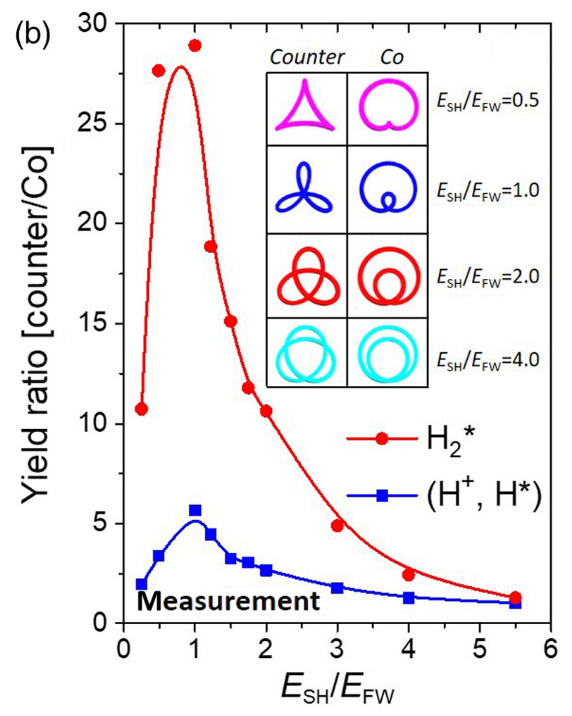 Multiphoton resonant excitation and frustrated tunneling ionization, manifesting the photonic and optical nature of the driving light via direct excitation and electron recapture, respectively, are complementary mechanisms to access Rydberg state excitation (RSE) of atoms and molecules in an intense laser field. However, clear identification and manipulation of their individual contributions in the light-induced RSE process remain experimentally challenging. Here, we bridge this gap by exploring the dissociative and nondissociative RSE of H2 molecules using bicircular two-color laser pulses. Depending on the relative field strength and polarization helicity of the two colors, the RSE probability can be boosted by more than one order of magnitude by exploiting the laser waveform-dependent field effect (see Figure). The role of the photon effect is readily strengthened with increasing relative strength of the second-harmonic field of the two colors regardless of the polarization helicity. As compared to the nondissociative RSE forming H2*, the field effect in producing the dissociative RSE channel of (H+, H*) is moderately suppressed, which is primarily accessed via a three-step sequential process separated by molecular bond stretching. Our work paves the way toward a comprehensive understanding of the interplay of the underlying field and photon effects in the strong-field RSE process, as well as facilitating the generation of Rydberg states optimized with tailored characteristics. W. Zhang, Y. Ma, C. Lu, F. Chen, S. Pan, P. Lu, H. Ni, and J. Wu, Adv. Photon. 5, 016002 (2023). J. Ma, Y. Ma, P. Wang, F. Yang, L. Xiong, Y. Yang, H. Ni, J. Wu, and Z. Sun, Ultrafast Sci. 4, 0053 (2024). Featured in SPIE news and CLP news. Asymmetric attosecond photoionization in molecular shape resonance  A shape resonance emerges during the light absorption in many molecules with a gigantic burst amplitude and a lifetime of hundreds of attoseconds. Recent advances in attosecond metrology revealed the attosecond lifetime of the shape resonance. For a heteronuclear molecule, the asymmetric initial state and landscape of the molecular potential would lead to an asymmetric shape resonance, whose effect, however, has not been characterized yet. Here we employed an attosecond interferometer to investigate the molecular frame photoionization time delay in the vicinity of the shape resonance of the NO molecule (see Figure). Driven by photons with energy ranging from 23.8 eV to 36.5 eV, a 150 attosecond difference in the time delay was observed between photoemission from the N/O end. Our quantum scattering theoretical simulations reproduce well our experimental findings. It illustrates that the asymmetric time delay originates from the interference between resonant and non-resonant photoionization pathways. X. Gong, W. Jiang, J. Tong, J. Qiang, P. Lu, H. Ni, R. Lucchese, K. Ueda, and J. Wu, Phys. Rev. X 12, 011002 (2022). Transient valence charge localization 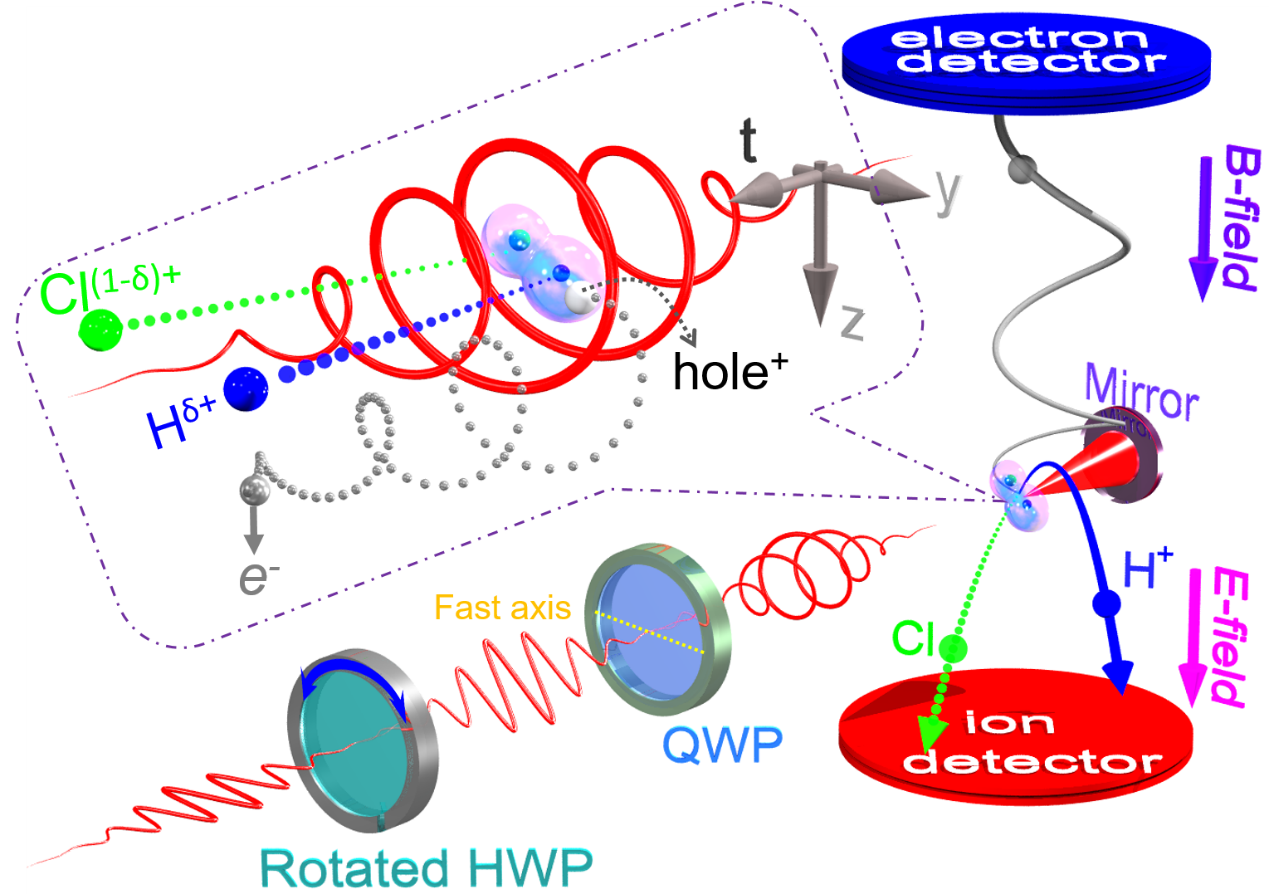 Probing transient charge localization in the inner-shell orbital of atoms and molecules has been made possible by recent progress of advanced light sources. Here, we demonstrate that the ultrafast electron tunneling ionization by an intense femtosecond laser pulse could induce an asymmetric transient charge localization in the valence shell of the HCl molecule during the dissociative ionization process. The transient charge localization is encoded in the recoil momentum acquired by the outgoing ionic fragments, and the asymmetry is revealed by carefully examining the electron tunneling-site distinguished momentum angular distribution of the ejected H+ fragment (see Figure). Our work proposes a way to visualize the transient valence charge motion and will stimulate further investigations of the tunneling-site-sensitive ultrafast dynamics of molecules in strong laser fields. J. Ma, L. Xu, H. Ni, C. Lu, W. Zhang, P. Lu, J. Wen, F. He, O. Faucher, and J. Wu, Phys. Rev. Lett. 127, 183201 (2021). F. Yang, H. Hou, J. Zhang, X. Li, P. Tang, Y. Mei, J. Ma, Z. Hu, H. Sun, H. Ni, X.-B. Wang, J. Wu, Z. Sun, and Y. Yang, J. Phys. Chem. Lett. 16, 13271 (2025). Subcycle linear momentum transfer in tunneling ionization 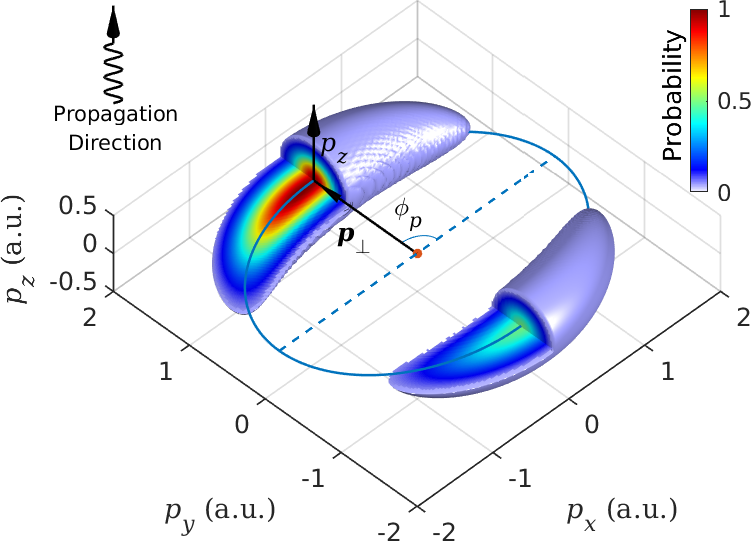 Interaction of a strong laser pulse with matter transfers not only energy but also linear momentum of the photons. Recent experimental advances have made it possible to detect the small amount of linear momentum delivered to the photoelectrons in strong-field ionization of atoms. We present numerical simulations as well as an analytical description of the subcycle phase (or time) resolved momentum transfer to an atom accessible by an attoclock protocol (see Figure). We show that the light-field-induced momentum transfer is remarkably sensitive to properties of the ultrashort laser pulse such as its carrier-envelope phase and ellipticity. Moreover, we show that the subcycle-resolved linear momentum transfer can provide novel insights into the interplay between nonadiabatic and nondipole effects in strong-field ionization. This work paves the way towards the investigation of the so-far unexplored time-resolved nondipole nonadiabatic tunneling dynamics. H. Ni, S. Brennecke, X. Gao, P.-L. He, S. Donsa, I. Březinová, F. He, J. Wu, M. Lein, X.-M. Tong, and J. Burgdörfer, Phys. Rev. Lett. 125, 073202 (2020). K. Lin, S. Brennecke, H. Ni, X. Chen, A. Hartung, D. Trabert, K. Fehre, J. Rist, X.-M. Tong, J. Burgdörfer, L. Ph. H. Schmidt, M. S. Schöffler, T. Jahnke, M. Kunitski, F. He, M. Lein, S. Eckart, and R. Dörner, Phys. Rev. Lett. 128, 023201 (2022). [Editors' Suggestion] X. Mao, H. Ni, X. Gong, J. Burgdörfer, and J. Wu, Phys. Rev. A 106, 063105 (2022). X. Mao, H. Ni, and J. Wu, Phys. Rev. A 110, 063113 (2024). X. Mao, H. Ni, and J. Wu, J. Phys. Commun. 9, 125001 (2025). Polarization tagging of two-photon double ionization by elliptically polarized XUV pulses 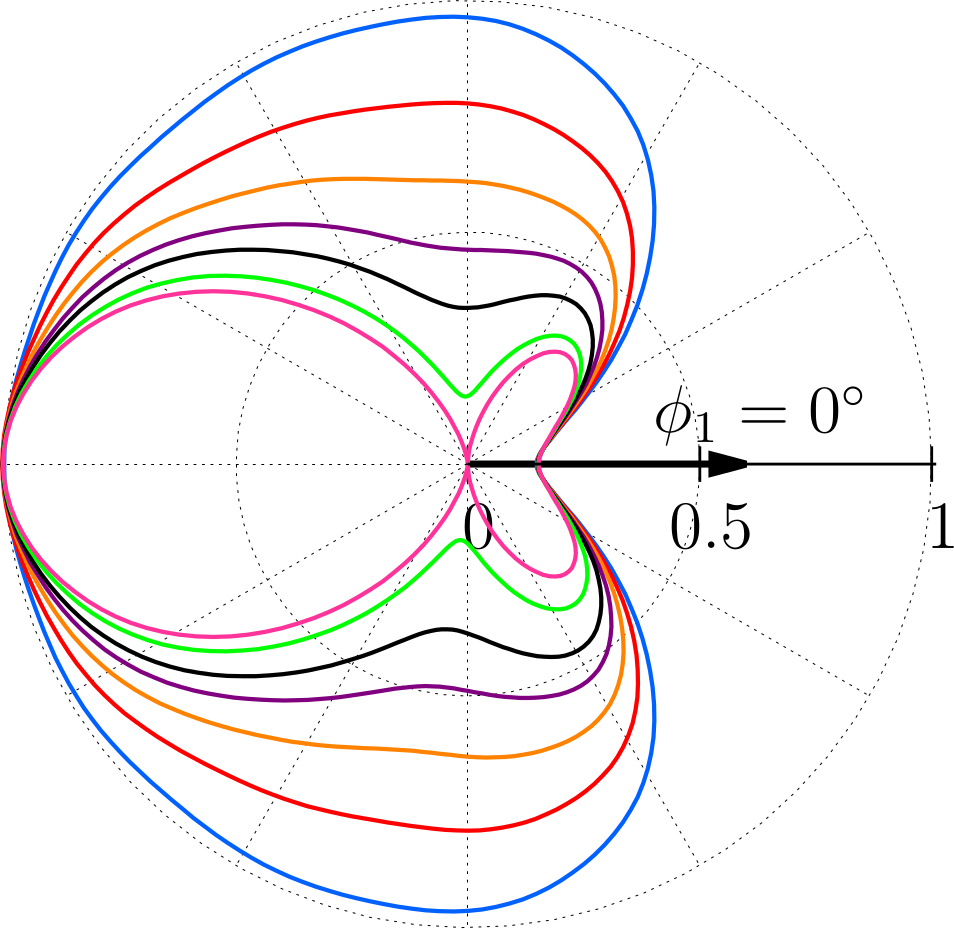 We explore the influence of elliptical polarization on the (non)sequential two-photon double ionization of atomic helium with ultrashort extreme ultraviolet (XUV) light fields using time-dependent full ab initio simulations. The energy and angular distributions of photoelectrons are found to be strongly dependent on the ellipticity. The correlation minimum in the joint angular distribution becomes more prominently visible with increasing ellipticity (see Figure). In a pump-probe sequence of two subsequent XUV pulses with varying ellipticities, polarization tagging allows us to discriminate between sequential and nonsequential photoionization. This clear separation demonstrates the potential of elliptically polarized XUV fields for improved control of electronic emission processes. S. Donsa, I. Březinová, H. Ni, J. Feist, and J. Burgdörfer, Phys. Rev. A 99, 023413 (2019). Deformation of atomic p± orbitals in strong elliptically polarized laser fields: Ionization time drifts and spatial photoelectron separation 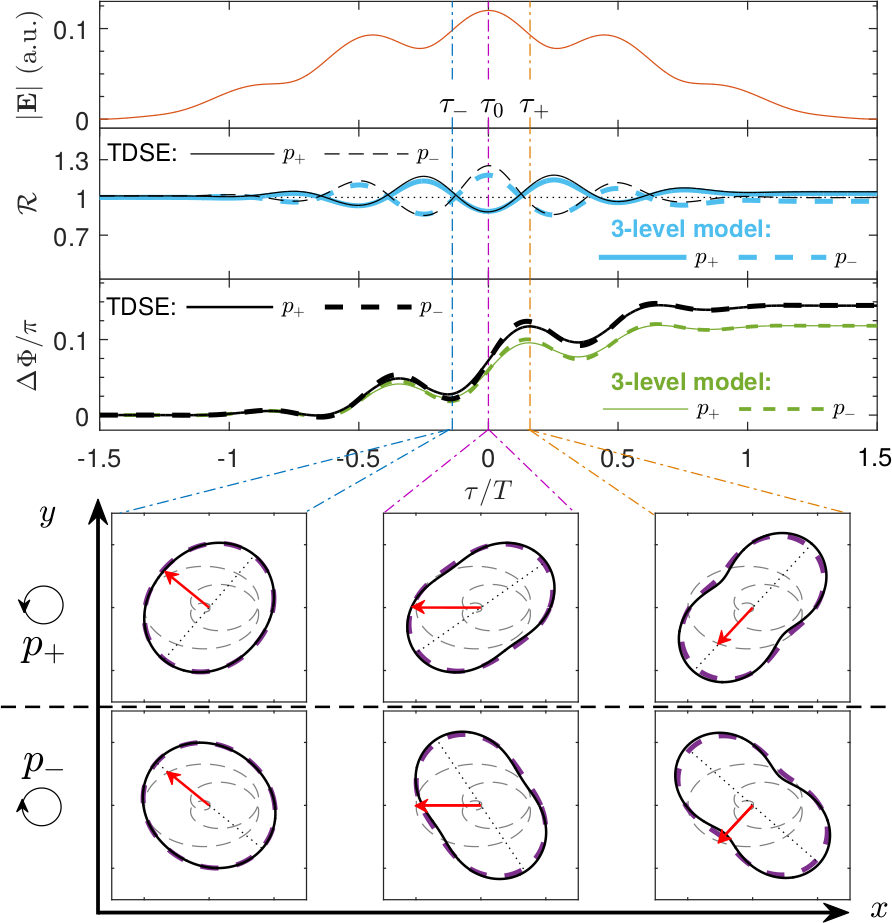 The dynamical orbital shape has so far eluded the studies of strong-field ionization. We theoretically investigate the deformation of atomic p± orbitals driven by strong elliptically polarized (EP) laser fields and the role it plays in tunnel ionization. Our study reveals that different Stark effects induced by orthogonal components of the EP field give rise to subcycle rearrangement of the bound electron density, rendering the initial p+ and p− orbitals deformed and polarized along distinctively tilted angles with respect to the polarization ellipse of the EP field (see Figure). As a consequence, the instantaneous tunneling rates change such that for few-cycle EP laser pulses the bound electron initially counter-rotating (co-rotating) with the electric field is most likely released before (after) the peak of the electric field. We demonstrate that with a sequential-pulse setup one can exploit this effect to spatially separate the photoelectrons detached from p+ and p- orbitals, paving the way towards robust control of spin-resolved photoemission in laser-matter interactions. K. Liu, H. Ni, K. Renziehausen, J.M. Rost, and I. Barth, Phys. Rev. Lett. 121, 203201 (2018). Debate over Tunneling Time Delay Resolved by Backpropagation 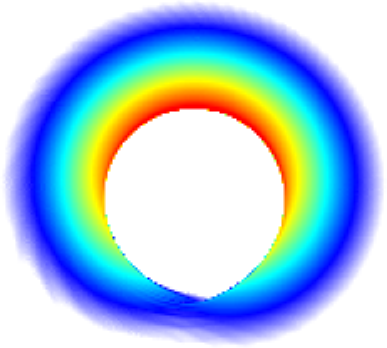 We proposed a backpropagation method to temporally and spatially resolve the tunneling ionization dynamics. The backpropagation method involves a full quantum solution of the tunneling ionization followed by a classical propagation backwards in time in phase space to retrieve initial tunneling exit coordinates, including time and position (see Figure). In contrast to other methods, this method does not employ any assumptions or approximations to the quantum tunneling dynamics, while it is capable to obtain highly differential information regarding to the tunneling process. Thereby, we could also quantify the fraction of electrons that are ionized via tunneling, herewith we able to determine if ionization is in the tunneling regime in the first place. The backpropagation method also enables comparison of different definitions of and approximations to the tunnel exit on the same footing. A direct comparison including or not nonadiabatic tunneling effects reveals, that a positive tunneling time delay results if nonadiabaticity is not considered while a zero delay is obtained if nonadiabatic effects are taken full and consistent account of, thus resolving the long-standing debate over the existence of a finite tunneling delay. H. Ni, U. Saalmann, and J.M. Rost, Phys. Rev. Lett. 117, 023002 (2016). H. Ni, U. Saalmann, and J.M. Rost, Phys. Rev. A 97, 013426 (2018). H. Ni, N. Eicke, C. Ruiz, J. Cai, F. Oppermann, N.I. Shvetsov-Shilovski, and L.W. Pi, Phys. Rev. A 98, 013411 (2018). Y. Ma, J. Zhou, P. Lu, H. Ni, and J. Wu, J. Phys. B 54, 144001 (2021). [Invited Article] C. Hofmann, A. Bray, W. Koch, H. Ni, and N.I. Shvetsov-Shilovski, Eur. Phys. J. D 75, 208 (2021). [Invited Review] Double Photoionization of Helium Dimer 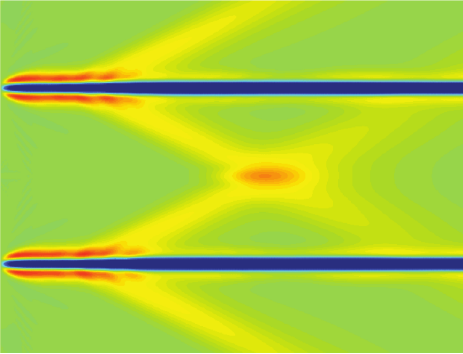 We studied the energy exchange between electrons in a helium dimer upon photon absorption. Results of numerical simulations for double photoionization are found to be in good agreement with recent experimental data for the angular distribution of the emitted electrons. Together with the temporal evolution of the two-electron probability distribution (see Figure) this provides direct evidence for the knockout mechanism. According to this mechanism, the photon energy, which is initially absorbed by an electron at one of the atoms in the dimer, is then shared between the electrons over distances of several Angstroms via an internal collisional process. Using a Hamiltonian reduction method we were also able to study the role of the interactions between different particles in the process. H. Ni, C. Ruiz, R. Dörner, and A. Becker, Phys. Rev. A 88, 013407 (2013). H. Ni and A. Becker, Phys. Rev. A 89, 033402 (2014). H. Huang, H. Ni, J. Wu, Y. Yang, J. Ma, and Z. Sun, Phys. Rev. A 112, 013122 (2025). Featured by Phys. Rev. A in their Kaleidoscope. Delayed Resonant Two-Photon Ionization 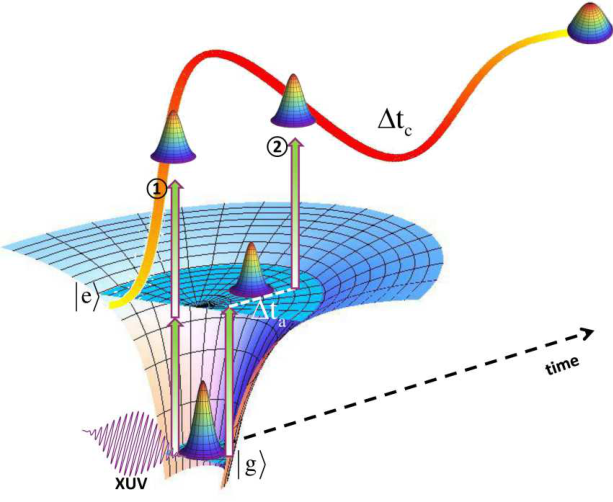 The advancements in the understanding of the attosecond streaking camera technique opens the perspective to retrieve time-resolved information about the dynamics of electrons during transitions inside an atom or molecule. As a prototype example, we showed how the time delay in the resonant two-photon ionization as compared to the instantaneous transition from the ground state to the continuum in a nonresonant process (see Figure) can be retrieved from numerical results for attosecond streaking traces. We found that, the transition delay is linearly proportional to the duration of the ionizing pulse. J. Su, H. Ni, A. Jaroń-Becker, and A. Becker, Phys. Rev. Lett. 113, 263002 (2014). Finite-Range Attosecond Time Delays in Photoionization 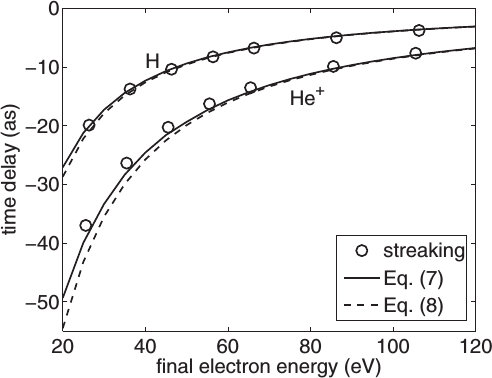 Measurements of the photoelectron momentum as a function of the delay between an ionizing XUV and a superimposed infrared streaking pulse have recently revealed temporal offsets for the electron emission from different shells of an atom. We showed that results of related numerical simulations and classical analysis (see Figure) can be interpreted as due to the dynamics of the photoelectron in the Coulomb field of the parent ion and the streaking field. Thus, the time delay is accumulated over a finite range in space, which the photoelectron probes after its transition into the continuum until the streaking pulse ceases. J. Su, H. Ni, A. Becker, and A. Jaroń-Becker, Phys. Rev. A 87, 033420 (2013). J. Su, H. Ni, A. Becker, and A. Jaroń-Becker, J. Mod. Opt. 60, 1484 (2013). J. Su, H. Ni, A. Becker, and A. Jaroń-Becker, Phys. Rev. A 88, 023413 (2013). J. Su, H. Ni, A. Becker, and A. Jaroń-Becker, Chin. J. Phys. 52, 404 (2014). [Invited Review] J. Su, H. Ni, A. Becker, and A. Jaroń-Becker, Phys. Rev. A 89, 013404 (2014). Y. Gao, H. Ni, A. Becker, and J. Wu, Sci. China: Phys. Mech. Astron. 67, 124203 (2024). Selection Rules in Few-Photon Double Ionization 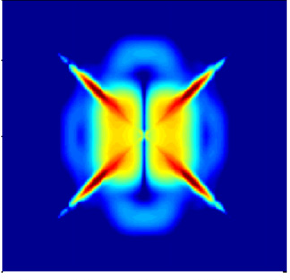 We analyzed the selection rules for the emission of two electrons from the helium atom following the absorption of a few photons from a laser field. The increase of the number of absorbed photons leads to alternating suppression and non-suppression of the back-to-back emission of the two electrons. The Figure shows a snapshot of the two-electron dynamics following single-photon (inner part of distribution) and two-photon double ionization (outer part of distribution). H. Ni, S. Chen, C. Ruiz, and A. Becker, J. Phys. B 44, 175601 (2011). Featured by J. Phys. B in their LabTalk and as the cover article.
学术成果
代表成果高亮成果 Ultrafast Electron–Dipole Interactions in TeO− Photodetachment
Fan Yang, Haomai Hou, Jian Zhang, Xueying Li, Peng Tang, Ye Mei, Junyang Ma, Zhubin Hu, Haitao Sun, Hongcheng Ni*, Xue-Bin Wang*, Jian Wu, Zhenrong Sun*, and Yan Yang*
Journal of Physical Chemistry Letters 16, 13271 (2025). ▶ PDF ▶ SuppMat Nondipole tunneling dynamics in strong-field ionization from atomic p orbitals
Xiaodan Mao, Hongcheng Ni*, and Jian Wu
Journal of Physics Communications 9, 125001 (2025). [Invited Article] ▶ PDF Localization and Delocalization of a Single Molecule in a Helium Nanodroplet
Zhengjun Ye#, Haomai Hou#, Linqian Zeng, Lianrong Zhou, Zhejun Jiang, Menghang Shi, Chenxu Lu, Shengzhe Pan, Ruolin Gong, Peifen Lu, Hongcheng Ni*, Wenbin Zhang*, Feng He*, and Jian Wu*
Physical Review Letters 135, 213202 (2025). [Editors' Suggestion] [Featured in Physics] ▶ PDF ▶ SuppMat Long-range electron correlation in dissociative double ionization of argon dimers
Hao Huang, Hongcheng Ni*, Jian Wu, Yan Yang, Junyang Ma*, and Zhenrong Sun
Physical Review A 112, 013122 (2025). ▶ PDF Photon Momentum Transfer and Partitioning: From One to Many
Xiaodan Mao, Hongcheng Ni*, Kang Lin*, Pei-Lun He, Hao Liang, Sebastian Eckart, Feng He, Kiyoshi Ueda, Reinhard Dörner, and Jian Wu*
Nature Communications 16, 5977 (2025). ▶ PDF ▶ SuppMat Modification of the saddle-point equation for strong-field ionization from atomic p orbitals
Xiaodan Mao, Kunlong Liu*, Hongcheng Ni*, and Jian Wu
Physical Review A 111, 033113 (2025). ▶ PDF Distinct role of electric field and vector potential in strong-field tunneling ionization
Yongzhe Ma#, Xiaodan Mao#, Lanhe Kong, Qingcao Liu, Hongcheng Ni*, and Jian Wu
Physical Review A 111, 033103 (2025). ▶ PDF eTraj.jl: Trajectory-based simulation for strong-field ionization
Mingyu Zhu, Hongcheng Ni*, and Jian Wu
Computer Physics Communications 311, 109549 (2025). ▶ PDF ▶ Code Visualization of subcycle nonadiabatic-nondipole coupling in strong-field ionization
Xiaodan Mao, Hongcheng Ni*, and Jian Wu
Physical Review A 110, 063113 (2024). ▶ PDF Impact of nuclear motion on light-induced bimolecular interaction dynamics
Menghang Shi#, Hao Huang#, Chenxu Lu#, Shengzhe Pan, Lianrong Zhou, Zhejun Jiang, Hongcheng Ni*, Wenbin Zhang*, and Jian Wu*
Physical Review X 14, 041001 (2024). ▶ PDF Subcycle Conservation Law in Strong-Field Ionization
Yongzhe Ma, Hongcheng Ni*, Yang Li, Feng He, and Jian Wu*
Ultrafast Science 4, 0071 (2024). ▶ PDF ▶ SuppMat Self-consistent extraction of photoabsorption time delays in attosecond streak camera
Yutong Gao, Hongcheng Ni*, Andreas Becker, and Jian Wu
Science China: Physics, Mechanics & Astronomy 67, 124203 (2024). ▶ PDF Ultrafast formation dynamics of D3+ from bimolecular reaction of the D2-D2 dimer
Hao Huang, Haomai Hou, Jin Wen*, Hongcheng Ni*, and Jian Wu*
Physical Review A 109, 043107 (2024). ▶ PDF Ultrafast photoinduced C-H bond formation from two small inorganic molecules
Zhejun Jiang, Hao Huang, Chenxu Lu, Lianrong Zhou, Shengzhe Pan, Junjie Qiang, Menghang Shi, Zhengjun Ye, Peifen Lu, Hongcheng Ni*, Wenbin Zhang*, and Jian Wu*
Nature Communications 15, 2854 (2024). ▶ PDF ▶ SuppMat Two-Dimensional Control of Rydberg Fragment Emission in Dissociative Frustrated Ionization of Oxygen
Junyang Ma#, Yongzhe Ma#, Pengzhao Wang, Fan Yang, Lei Xiong, Yan Yang, Hongcheng Ni*, Jian Wu, and Zhenrong Sun*
Ultrafast Science 4, 0053 (2024). ▶ PDF ▶ SuppMat Advances in Timing and Control of Ultrafast Molecular Dynamics: From XUV to Infrared
Wenyu Jiang, Shengzhe Pan, Hao Huang, Jihong Tong, Wenbin Zhang, Hongcheng Ni*, and Jian Wu
Journal of Physics B 57, 212001 (2024). [Invited Review] ▶ PDF Attosecond Ionization Time Delays in Strong-Field Physics
Yongzhe Ma, Hongcheng Ni*, and Jian Wu*
Chinese Physics B 33, 013201 (2024). [Invited Review] [CPB Highlights of 2024] ▶ PDF Probing and Steering Attosecond Electron Motion Using Tailored Ultrafast Laser Fields
Xiaochun Gong*, Wenbin Zhang, Peifen Lu, Hongcheng Ni, and Jian Wu*
Journal of Physical Chemistry A 128, 401 (2024). [Invited Review] ▶ PDF 阿秒光脉冲:探秘微观世界的时间之窗
朱明宇, 倪宏程*, 吴健
科学 76 (1), 56 (2024). [特邀科普] [新华文摘转载] ▶ PDF Ultrafast formation dynamics of D3+ from the light-driven bimolecular reaction of the D2–D2 dimer
Lianrong Zhou, Hongcheng Ni, Zhejun Jiang, Junjie Qiang, Wenyu Jiang, Wenbin Zhang, Peifen Lu, Jin Wen*, Kang Lin*, Meifang Zhu, Reinhard Dörner, and Jian Wu*
Nature Chemistry 15, 1229 (2023). ▶ PDF PyStructureFactor: A Python code for the molecular structure factor in tunneling ionization rates
Shanshan Song#, Mingyu Zhu#, Hongcheng Ni*, and Jian Wu*
Computer Physics Communications 292, 108882 (2023). ▶ PDF ▶ Code Ionization induced by the ponderomotive force in intense and high-frequency laser fields
Mingyu Zhu, Yuxiang Liu, Chunli Wei, Hongcheng Ni*, and Qi Wei*
Journal of Chemical Physics 158, 164306 (2023). ▶ PDF Rydberg State Excitation in Molecules Manipulated by Bicircular Two-Color Laser Pulses
Wenbin Zhang*, Yongzhe Ma, Chenxu Lu, Fei Chen, Shengzhe Pan, Peifen Lu, Hongcheng Ni*, and Jian Wu*
Advanced Photonics 5, 016002 (2023). ▶ PDF Subcycle-resolved strong-field tunneling ionization: Identification of magnetic dipole and electric quadrupole effects
Xiaodan Mao, Hongcheng Ni*, Xiaochun Gong, Joachim Burgdörfer, and Jian Wu*
Physical Review A 106, 063105 (2022). ▶ PDF Light-Induced Ultrafast Molecular Dynamics: From Photochemistry to Optochemistry
Hui Li, Xiaochun Gong, Hongcheng Ni, Peifen Lu, Xiao Luo, Jin Wen, Youjun Yang, Xuhong Qian, Zhenrong Sun, and Jian Wu*
Journal of Physical Chemistry Letters 13, 5881 (2022). [Invited Review] ▶ PDF Magnetic-Field Effect in High-Order Above-Threshold Ionization
Kang Lin*, Simon Brennecke, Hongcheng Ni, Xiang Chen, Alexander Hartung, Daniel Trabert, Kilian Fehre, Jonas Rist, Xiao-Min Tong, Joachim Burgdörfer, Lothar Ph. H. Schmidt, Markus S. Schöffler, Till Jahnke, Maksim Kunitski, Feng He, Manfred Lein, Sebastian Eckart, and Reinhard Dörner*
Physical Review Letters 128, 023201 (2022). [Editors' Suggestion] ▶ PDF Asymmetric Attosecond Photoionization in Molecular Shape Resonance
Xiaochun Gong, Wenyu Jiang, Jihong Tong, Junjie Qiang, Peifen Lu, Hongcheng Ni*, Robert Lucchese, Kiyoshi Ueda*, and Jian Wu*
Physical Review X 12, 011002 (2022). ▶ PDF Transient Valence Charge Localization in Strong-Field Dissociative Ionization of HCl Molecules
Junyang Ma, Liang Xu, Hongcheng Ni*, Chenxu Lu, Wenbin Zhang, Peifen Lu, Jin Wen, Feng He, Olivier Faucher, and Jian Wu*
Physical Review Letters 127, 183201 (2021). ▶ PDF ▶ SuppMat Influence of nonadiabatic, nondipole and quantum effects on the attoclock signal
Yongzhe Ma, Jinyu Zhou, Peifen Lu, Hongcheng Ni*, and Jian Wu*
Journal of Physics B 54, 144001 (2021). [Invited Article] ▶ PDF Quantum battles in attoscience: tunnelling
Cornelia Hofmann*, Alexander Bray, Werner Koch, Hongcheng Ni, and Nikolay I. Shvetsov-Shilovski
European Physical Journal D 75, 208 (2021). [Invited Review] ▶ PDF Theory of Subcycle Linear Momentum Transfer in Strong-Field Tunneling Ionization
Hongcheng Ni*, Simon Brennecke, Xiang Gao, Pei-Lun He*, Stefan Donsa, Iva Březinová, Feng He, Jian Wu, Manfred Lein, Xiao-Min Tong, and Joachim Burgdörfer*
Physical Review Letters 125, 073202 (2020). ▶ PDF ▶ SuppMat Polarization tagging of two-photon double ionization by elliptically polarized XUV pulses
Stefan Donsa*, Iva Březinová, Hongcheng Ni*, Johannes Feist, and Joachim Burgdörfer
Physical Review A 99, 023413 (2019). ▶ PDF Deformation of atomic p± orbitals in strong elliptically polarized laser fields: Ionization time drifts and spatial photoelectron separation
Kunlong Liu, Hongcheng Ni*, Klaus Renziehausen, Jan-Michael Rost*, and Ingo Barth*
Physical Review Letters 121, 203201 (2018). ▶ PDF ▶ SuppMat Tunneling criteria and a nonadiabatic term for strong-field ionization
Hongcheng Ni, Nicolas Eicke, Camilo Ruiz, Jun Cai, Florian Oppermann, Nikolay I. Shvetsov-Shilovski, and Liang-Wen Pi*
Physical Review A 98, 013411 (2018). ▶ PDF Tunneling exit characteristics from classical backpropagation of an ionized electron wave packet
Hongcheng Ni, Ulf Saalmann, and Jan-Michael Rost
Physical Review A 97, 013426 (2018). ▶ PDF Tunneling ionization time resolved by backpropagation
Hongcheng Ni, Ulf Saalmann, and Jan-Michael Rost
Physical Review Letters 117, 023002 (2016). ▶ PDF Time delays in two-photon ionization
Jing Su, Hongcheng Ni, Agnieszka Jaroń-Becker, and Andreas Becker
Physical Review Letters 113, 263002 (2014). ▶ PDF Theoretical analysis of the role of Coulomb interactions in single and double photoionization of the helium dimer using numerical model simulations
Hongcheng Ni and Andreas Becker
Physical Review A 89, 033402 (2014). ▶ PDF Attosecond streaking time delays: Finite-range property and comparison of classical and quantum approaches
Jing Su*, Hongcheng Ni, Andreas Becker, and Agnieszka Jaroń-Becker
Physical Review A 89, 013404 (2014). ▶ PDF Numerical simulations of attosecond streaking time delays in photoionization
Jing Su, Hongcheng Ni, Andreas Becker, and Agnieszka Jaroń-Becker
Chinese Journal of Physics 52, 404 (2014). [Invited Review] ▶ PDF Finite-range time delays in numerical attosecond streaking experiments
Jing Su, Hongcheng Ni, Andreas Becker, and Agnieszka Jaroń-Becker
Physical Review A 88, 023413 (2013). ▶ PDF Numerical simulations of single-photon double ionization of the helium dimer
Hongcheng Ni, Camilo Ruiz, Reinhard Dörner, and Andreas Becker
Physical Review A 88, 013407 (2013). ▶ PDF Theoretical analysis of time delays and streaking effects in XUV photoionization
Jing Su*, Hongcheng Ni, Andreas Becker, and Agnieszka Jaroń-Becker
Journal of Modern Optics 60, 1484 (2013). ▶ PDF Numerical simulation of time delays in light-induced ionization
Jing Su, Hongcheng Ni, Andreas Becker, and Agnieszka Jaroń-Becker
Physical Review A 87, 033420 (2013). ▶ PDF Selection rules in the few-photon double ionization of the helium atom
Hongcheng Ni*, Shaohao Chen, Camilo Ruiz, and Andreas Becker*
Journal of Physics B 44, 175601 (2011). [Cover Article] ▶ PDF 光衍射法研究水表面波的性质
倪宏程, 林锦达, 王思慧, 周进, 周惠君
大学物理 26 (10), 60 (2007). [编辑推荐] ▶ PDF
荣誉及奖励
| 2025 | 2024中国光学十大进展基础研究类提名奖 | | 2024 | 2023中国光学十大进展基础研究类提名奖 | | 2021 | 国家海外优青 | | 2021 | 华东师范大学紫江优秀青年学者 | | 2021 | 上海科技青年35人引领计划 | | 2020 | 上海市千人计划 | | 2019 | 华东师范大学紫江青年学者 | | 2019 | 英国物理学会优秀审稿人 | | 2019 | 奥地利迈特纳学者 | | 2015 | 德国洪堡学者 | | 2013 | 美国科罗拉多大学Beverly Sears研究奖学金 |
|
